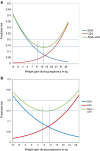Associations of pre-pregnancy body mass index and gestational weight gain with pregnancy outcome and postpartum weight retention: a prospective observational cohort study
- PMID: 24917037
- PMCID: PMC4062904
- DOI: 10.1186/1471-2393-14-201
Associations of pre-pregnancy body mass index and gestational weight gain with pregnancy outcome and postpartum weight retention: a prospective observational cohort study
Abstract
Background: Excessive gestational weight gain (GWG) is associated with pregnancy complications, and Norwegian Health Authorities have adopted the GWG recommendations of the US Institute of Medicine and National Research Council (IOM). The aim of this study was to evaluate if a GWG outside the IOM recommendation in a Norwegian population is associated with increased risk of pregnancy complications like hypertension, low and high birth weight, preeclampsia, emergency caesarean delivery, and maternal post-partum weight retention (PPWR) at 6 and 18 months.
Methods: This study was performed in 56 101 pregnant women included in the prospective national Norwegian Mother and Child Cohort Study (MoBa) in the years 1999 to 2008. Women who delivered a singleton live born child during gestational week 37 to 42 were included. Maternal prepregnant and postpartum weight was collected from questionnaires at 17th week of gestation and 6 and 18 months postpartum.
Results: A weight gain less than the IOM recommendations (GWG < IOM rec.) increased the risk for giving birth to a low weight baby among normal weight nulliparous women. A weight gain higher than the IOM recommendations (GWG > IOM rec.) significantly increased the risk of pregnancy hypertension, a high birth weight baby, preeclampsia and emergency cesarean delivery in both nulliparous and parous normal weight women. Similar results were found for overweight women except for no increased risk for gestational hypertension in parous women with GWG > IOM rec. Seventy-four percent of the overweight nulliparous women and 66% of the obese women had a GWG > IOM rec. A GWG > IOM rec. resulted in increased risk of PPWR > 2 kg in all weight classes, but most women attained their prepregnant weight class by 18 months post-partum.
Conclusions: For prepregnant normal weight and overweight women a GWG > IOM rec. increased the risk for unfavorable birth outcomes in both nulliparous and parous women. A GWG > IOM rec. increased the risk of a PPWR > 2 kg at 18 months in all weight classes. This large study supports the Norwegian Health authorities' recommendations for normal weight and overweight women to comply with the IOM rec.
Figures


References
-
- Institute of Medicine, Committee to Reexamine IOM Pregnancy Weight Guidelines, Food and Nutrition Board and Board on Children Y, and Families. Weight Gain during Pregnancy: Reexamining the Guidelines. Washington: The National Academies press; 2009.
Publication types
MeSH terms
Grants and funding
LinkOut - more resources
Full Text Sources
Other Literature Sources
Medical

